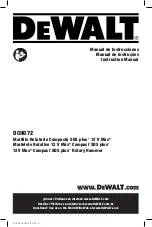
7
CAUTION:
•
As soon as the torque limiter actuates, switch off
the tool immediately. This will help prevent
premature wear of the tool.
Indicator lamp
Fig.7
The green power-ON indicator lamp lights up when the
tool is plugged. If the indicator lamp does not light up,
the main cord or the controller may be defective. The
indicator lamp is lit but the tool does not start even if the
tool is switched on, the carbon brushes may be worn out,
or the controller, the motor or the ON/OFF switch may be
defective.
The red service indicator lamp lights up when the carbon
brushes are nearly worn out to indicate that the tool
needs servicing. After approx. 8 hours of use, the motor
will automatically be shut off.
ASSEMBLY
CAUTION:
•
Always be sure that the tool is switched off and
unplugged before carrying out any work on the
tool.
Installing side grip (auxiliary handle)
Fig.8
CAUTION:
•
Always use the side grip to ensure operating safety
when drilling in concrete, masonry, etc.
The side grip swings around to either side, allowing easy
handling of the tool in any position. Loosen the side grip
by turning it counterclockwise, swing it to the desired
position and then tighten it by turning clockwise.
Installing or removing the bit
Fig.9
Clean the bit shank and apply bit grease before installing
the bit.
Insert the bit into the tool. Turn the bit and push it in until
it engages.
Fig.10
If the bit cannot be pushed in, remove the bit. Pull the
chuck cover down a couple of times. Then insert the bit
again. Turn the bit and push it in until it engages.
After installing, always make sure that the bit is securely
held in place by trying to pull it out.
To remove the bit, pull the chuck cover down all the way
and pull the bit out.
Fig.11
Bit angle (when chipping, scaling or
demolishing)
Fig.12
The bit can be secured at 24 different angles. To change
the bit angle, depress the lock button and rotate the
change lever so that the pointer points to the
symbol.
Turn the bit to the desired angle.
Depress the lock button and rotate the change lever so
that the pointer points to the
symbol. Then make sure
that the bit is securely held in place by turning it slightly.
Depth gauge
Fig.13
The depth gauge is convenient for drilling holes of
uniform depth. Loosen the clamp screw and adjust the
depth gauge to the desired depth. After adjusting,
tighten the clamp screw firmly.
NOTE:
•
The depth gauge cannot be used at the position
where the depth gauge strikes against the gear
housing/motor housing.
OPERATION
CAUTION:
•
Always use the side grip (auxiliary handle) and
firmly hold the tool by both side grip and switch
handle during operations.
Hammer drilling operation
Fig.14
Set the change lever to the
symbol.
Position the bit at the desired location for the hole, then
pull the switch trigger. Do not force the tool. Light
pressure gives best results. Keep the tool in position and
prevent it from slipping away from the hole.
Do not apply more pressure when the hole becomes
clogged with chips or particles. Instead, run the tool at
an idle, then remove the bit partially from the hole. By
repeating this several times, the hole will be cleaned out
and normal drilling may be resumed.
CAUTION:
•
When the bit begins to break through concrete or if
the bit strikes reinforcing rods embedded in
concrete, the tool may react dangerously. Maintain
good balance and safe footing while holding the
tool firmly with both hands to prevent dangerous
reaction.
Blow-out bulb (optional accessory)
Fig.15
After drilling the hole, use the blow-out bulb to clean the
dust out of the hole.
Chipping/Scaling/Demolition
Fig.16
Set the change lever to the
symbol.
Hold the tool firmly with both hands. Turn the tool on and
apply slight pressure on the tool so that the tool will not
bounce around, uncontrolled. Pressing very hard on the
tool will not increase the efficiency.
Summary of Contents for HR3540C
Page 53: ...53 ...
Page 54: ...54 ...
Page 55: ...55 ...
Page 56: ...56 Makita Corporation Anjo Aichi Japan 884815C986 ...
































